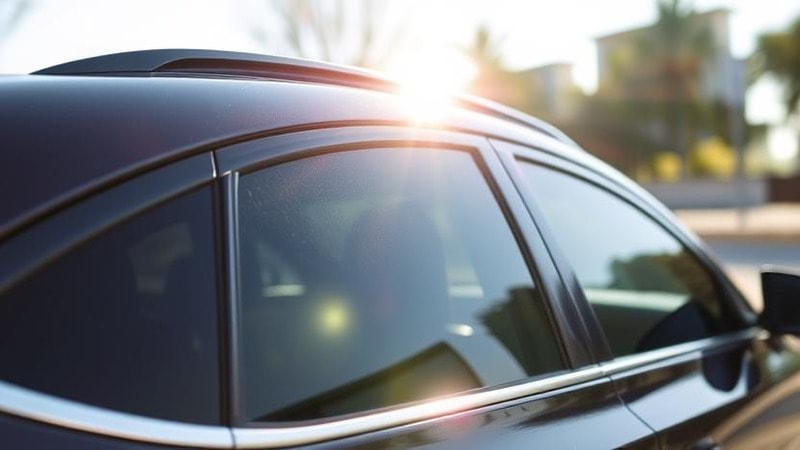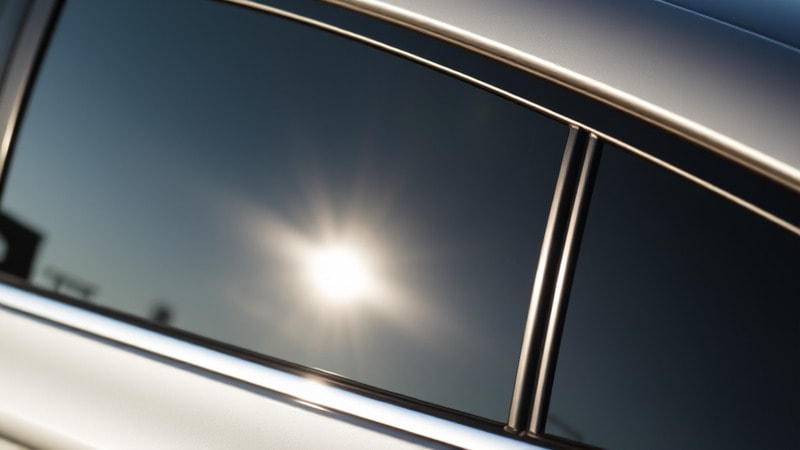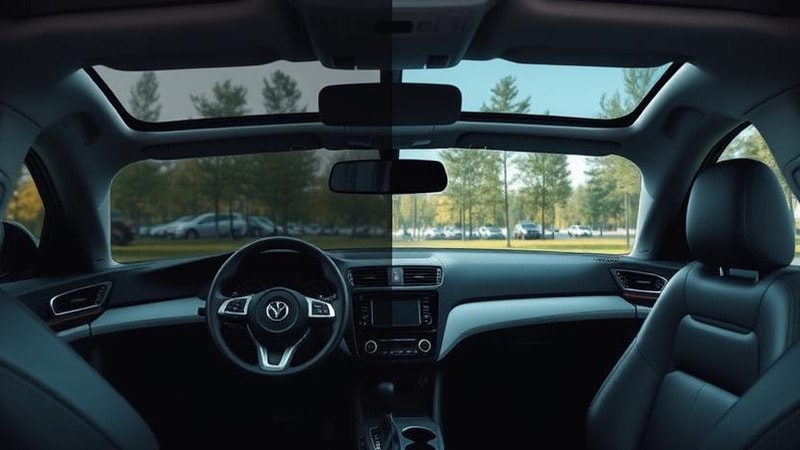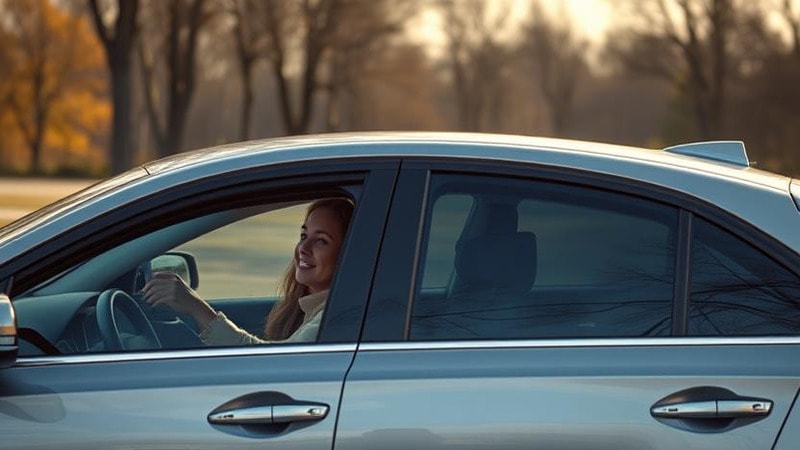Struggling to choose between carbon and ceramic window tints? Both block heat and UV rays while protecting privacy, but their performance and durability differ. Ceramic offers superior heat rejection and clarity, while carbon provides a sleek matte finish at a lower cost. Discover which tint is right for your needs—let’s break down the pros and cons to help you decide!
Understanding Window Tint
Window tint film is a protective coating put on car windows to improve comfort, style, and durability. By blocking some sunlight, it helps to reduce the vehicle’s interior heat buildup, resulting in a cooler car even on hot days.
One key benefit of window tint films is their capacity to filter harmful UV rays. They shield you and the car’s interior from prolonged sun exposure, thus minimizing fading and damage. Tinted windows also minimize glare, which improves visibility and relieves eye strain, especially during bright daylight or nighttime driving. For these reasons, many commercial cars install window tint films to enjoy the benefits of reducing heat and glare.

Car window tints have different percentages and several types. Among the many kinds of window films available, carbon and ceramic films are particularly distinctive because they are more resistant to heat without sacrificing visibility, long-lasting nature, or efficiency. Understanding the differences between these two options is essential for selecting the best tint for your vehicle’s needs.
Key Features of Carbon and Ceramic Tint
Understanding the difference between carbon and ceramic coatings is critical when selecting a window tint. Each variety provides distinct advantages in terms of heat rejection, UV protection, durability, and cost. We’ll look at the distinguishing characteristics of carbon and ceramic tints to help you decide which option is best for you.
Carbon Tint Features
Carbon window tint contains small carbon particles that are inserted in the film. These carbon particles are responsible for absorbing light and reducing heat. The tiny carbon particles also darken the glass on car windows, thus repelling sunlight effectively.

The specially engineered structure with embedded carbon particles allows the tint to reduce visible light transmission, thus providing glare reduction and privacy. Reduced glare from oncoming traffic creates a comfortable environment for the driver by improving sight.
While carbon film can filter up to 99% of harmful UV radiation, it may not be as effective in heat rejection as ceramic tint. According to the stats, carbon tint rejects 66% of total solar energy and 91% of glare from blinding sunlight.
Furthermore, unlike dyed films, carbon tint does not fade over time, resulting in long-term color stability and a sleek, matte appearance.
Ceramic Tint Features
Ceramic window tint is created by embedding ceramic nanoparticles in the window film. The ceramic nanoparticles are non-metallic and non-conductive, thus making it one of the most advanced options. The nanotechnology, along with ceramic properties, provides this tint with its unique features.

The ceramic window tints provide exceptional heat rejection and UV protection. Unlike carbon tints, ceramic films can filter up to 99% of UV rays while retaining excellent clarity and visibility, especially at night. This makes ceramic tint an ideal alternative for people who want optimum protection for the safety of cars and drivers.
Furthermore, ceramic tint decreases interior heat more effectively than carbon film, keeping the cabin cool even in hot weather. Despite its increased price, its durability, performance, and resistance to glare and signal interference make it a worthwhile investment.
Head-to-Head Comparison: Carbon vs Ceramic Tint

Here is a table where we have made a head-to-head comparison of key factors of both carbon and ceramic window tints. By analyzing this table, you can make an informed decision about whether a carbon or ceramic tint best aligns with your priorities, budget, and driving needs.
| Feature | Carbon Tint | Ceramic Tint |
|---|---|---|
| Composition | Carbon particles infused in the film | Ceramic nanoparticles embedded in film |
| UV Protection | High | superior performance |
| Heat Rejection | Moderate | High |
| Glare Reduction | Good | Excellent |
| Visibility | Slightly darkens windows | Maintains high clarity even with higher percentage tints |
| Signal Interference | None | None |
| Aesthetics | bold, matte look | sleek finish |
| Durability | Fade-resistant, long-lasting | Most durable, high resistance to fading |
| Lifecycle | lasts 5–10 years | can last over 15 years |
| Cost | More affordable | More expensive but premium quality |
Carbon vs. Ceramic Tint: Which One is Better?
If you are still comparing the two tints and wondering which one is better, then read up on our analysis.

While both carbon and ceramic window tints have many advantages, their applications and price points differ. Carbon tint is a good mid-range choice, as it offers a smooth matte surface, good heat rejection, and UV protection.
It reduces glare and efficiently blocks infrared radiation, which helps to keep a car’s interior cool. It may eventually develop a tiny haze, though, and its heat rejection properties are not as great as those of ceramic tints.
On the other hand, ceramic tint is the premium alternative, excelling in heat rejection, UV protection, durability, and visibility. It uses nano-ceramic particles that block up to 99% of UV rays and have exceptional infrared reflection, considerably decreasing heat accumulation inside the car.
Unlike carbon tint, the ceramic film maintains outstanding clarity even at darker shades, resulting in improved nighttime visibility. Furthermore, ceramic tints are more resistant to scratches and fading, often lasting more than 15 years, whereas carbon tints only last 5-10 years.

Aesthetic differences further differentiate them, as carbon tint offers a dramatic, matte appearance that improves the appearance of a vehicle, and ceramic tint has a sleeker, more refined finish. Ceramic film is more expensive than carbon tint due to its advanced technology.
If you value long-term performance, heat control, and optimal UV protection, ceramic tint is well worth the price tag. Meanwhile, carbon tint remains an excellent low-cost option if you are seeking enough protection while maintaining an attractive, non-metallic appearance.
Benefits of Window Tinting
Window tinting is about more than just aesthetics and style; it has practical benefits that increase both comfort and provide protection. As you know, tinted windows reflect off infrared and UV rays; by doing so, it also reduces heat buildup inside the car.
This results in a cooler car interior, which adds to the comfort of the passengers. Moreover, a naturally cooler interior reduces the need for excessive air conditioning, thus improving fuel efficiency. While adding to the comfort level of your car, it raises the bar in aesthetic style by giving your vehicle a sleek and modern look.

Additionally, tinted films protect windows from scratches, preserving the vehicle’s original appearance and ensuring long-term durability. Another remarkable benefit of window tinting is its protective capabilities for the car’s interior. By reflecting UV rays, it protects dashboards, seats, and interior fabrics from fading and cracking. It keeps your car looking good as new for longer and also retains its resale value.
Last but not least, the tint adds a level of privacy to your car, thus preventing onlookers from looking in and harassing you or your fellow passengers. Moreover, the added privacy also protects your belongings from being stolen. If a thief cannot look inside the car, they won’t know if there are any valuables inside.
Things to Consider Before Getting Your Windows Tinted
Before investing in window tinting, you should be informed of the legal restrictions. Many states have restrictions governing tint darkness and reflectivity, and some provide medical exemptions for people who are sensitive to sunlight. Check your local legislation to select a legal tint percentage and to prevent yourself from facing hefty fines.

Another significant factor is the tint percentage, which controls how much light flows through your windows. Darker shades provide greater privacy and heat reduction but could hinder visibility, particularly at night. Choosing the appropriate balance between utility and legality is critical when choosing a window tint.
Upkeep and maintenance are also important in ensuring the longevity of your window tint. Avoid using harsh chemicals or abrasive cleaning instruments since these can damage the film. Instead, use a mild washing solution and a delicate cloth to keep the tint and your car in good condition.
Finally, always use a trustworthy supplier for sourcing and installation. A professional tinting service guarantees a flawless application, lowering the chances of peeling, bubbling, or uneven coverage. Investing in high-quality materials and a professional installation ensures long-term performance and protection.

Choosing the Right Tint for Your Vehicle
The perfect window tint for your car will rely on a number of criteria, such as your intended use, budget, climate, and aesthetics. Ceramic tint is the best option if you live in an area with a lot of sunlight, like Chicago’s bright days, because of its strong heat rejection and UV protection.
It provides outstanding clarity, even at darker shades, keeps your car cooler, and shields the interior from fading. However, its greater price may not be affordable for a tighter budget.
Carbon tint offers strong UV protection and a fashionable matte appearance at a lower cost for anyone seeking a more economical option. It is a sensible option even though it doesn’t block as much heat as ceramic film because it still significantly reduces glare and improves privacy.

Regardless of the tint type, hiring an experienced installer is essential to ensuring a flawless application. Poor installation might result in bubbling, peeling, or decreased durability over time. Then you have to remove the tint by yourself or by professionals.
A qualified installer will use high-quality film, offer warranties, and follow local tint laws. Before making a final decision, consider heat rejection capabilities, visibility, and long-term maintenance to get the most out of your investment.
Window Tint Installation and Maintenance
The quality of service a tint provides depends highly on its installation. A skilled window tint application offers a smooth, bubble-free finish and extends the life of the film. When choosing a tinting provider, search for installers who have experience with both carbon and ceramic films, as each requires precise application skills.
A professional provider should also offer a warranty or guarantee that covers problems like peeling, bubbling, or premature fading.

Moreover, proper maintenance is required to maintain the tint’s clarity and efficiency. Avoid rolling down the windows for at least 48 hours after installation to allow the glue to properly set. To avoid scratches and damage, clean using a moderate, ammonia-free cleaner and a soft microfiber cloth.
With proper installation and proper cleaning, your window tint can have a longer lifespan while delivering excellent heat dissipation, UV protection, and improved aesthetics.

FAQs
Q1. How long do the carbon and ceramic tints last?
Carbon tints normally last 5-10 years, although ceramic tints can last more than 15 years with proper installation and maintenance.
Q2. Is ceramic window tint worth the price?
While ceramic tint is more expensive upfront, it lasts longer and provides better performance, making it a worthwhile investment for those prioritizing comfort and protection.
Q3. Do you offer custom sizes and tint levels?
Yes, we provide a range of customization options, including various sizes and tint levels. Our team will work with you to ensure the window tint films meet your specific requirements.
Q4. Can I get samples before placing a bulk order?
Yes, we offer samples so you can assess the quality and performance of our window tint films. Contact us with your sample request, and we’ll arrange prompt delivery.
Conclusion
When deciding between carbon and ceramic tint, consider your budget and performance requirements. Ceramic tint offers superior UV protection, heat reflection, and long-term durability, making it the greatest option if you want to invest in premium quality.
Carbon tint is less expensive and provides excellent heat reflection, providing a sleek, matte appearance. Regardless of your choice, skilled installation guarantees peak performance and longevity.
Upgrade Your Ride with Premium Window Tint! Get a Quote Now!
Experience cooler, safer drives with CARLIKE’s professional-grade window tints – blocking 99% UV rays and reducing heat greatly. Our premium carbon tint film delivers superior heat rejection with a sleek matte finish, while our cutting-edge ceramic tint film offers maximum infrared rejection without compromising visibility.
Get a free, no-obligation consultation today! Discover which high-performance tint is perfect for your car!



